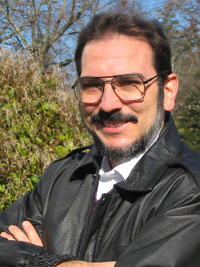 |
|
Current portrait of the writer.
|
BY GEORGE KHOURY
I wasn’t completely enthralled by comic books until I discovered Star Wars #68 from Marvel Comics. It was happenstance when that book found me at the newsstand. I was just a twelve-year-old Star Wars junkie dying to get a fix from the latest Starlog about Return of the Jedi, but that lone comic on a spinner rack - with its arresting Boba Fett cover - lured me into comics forever that day. I kept coming back for more of these Marvel Comics each week and discovered a goldmine of wonders: Uncanny X-Men by Chris Claremont and Paul Smith, Fantastic Four by John Byrne, Thor by Walter Simonson, Daredevil by Frank Miller and Klaus Janson, The New Defenders by J.M. DeMatteis and Don Perlin, etc... I was enchanted by the excitement-filled stories that I was getting from these Marvel epics – this was my golden age. But for my money, the best of all those comics were always the ones written by Mr. Roger Stern. The memorable stories he wrote have been ingrained fondly into my favorite memories, ‘cause whichever book Roger worked on, he always gave you your sixty cents worth and then some.
During his tenure at Marvel, he seemingly worked on all of the flagship titles (The Avengers, The Incredible Hulk, Doctor Strange, Captain America, Peter Parker, The Spectacular Spider-Man and Fantastic Four) at some point or another, and with only Marvel’s finest artists: John Romita Jr., Paul Smith, John Buscema, Michael Golden and John Byrne. Personally, I’ve always felt that he was the quintessential Marvel writer after Stan Lee because he not only managed to bring the jovial wordplay of Lee to a new Marvel generation, but he always gave us clever stories that were refreshing and contemporary. Highly regarded by most fans are the memorable stories that Roger wrote for Amazing Spider-Man, which not only produced classics like “The Kid Who Collected Spider-Man”, but helped redefined the character and created a formidable new nemesis in the form of The Hobgoblin. The crème de la crème of Stern’s Marvel work, and incidentally one of my favorite comics of all-time, is the Doctor Strange and Doctor Doom: Triumph and Torment graphic novel. In this epic (lavishly illustrated by Mike Mignola and Mark Badger), the writer shows us the lengths to which Victor von Doom - Marvel Comics’ biggest tyrant - will go to in order to rescue the soul of his beloved mother from the grips of the notorious devil named Mephisto. This beautiful tale is a classic and a testimony to Roger Stern’s gift for storytelling.
By the late '80s, Roger would begin work for DC Comics. Writing primarily for Action Comics – a hundred issues worth – and other Superman titles, his tenure was highlighted by one of the most successful comic book storylines of all-time: “The Death of Superman.” During the early '90s, his first prose novel successfully adapted “The Death and Life of Superman” and lasted five weeks on The New York Times Bestseller list. Subsequent novels included Smallville: Strange Visitors, which launched a series of novels featuring characters from the popular Smallville television series. Post-DC, he’s continued to turn out great comics like Avengers Forever (with writer Kurt Busiek and artist Carlos Pacheco), Superman vs. Hulk (with artist Steve Rude) and Avengers #1 1/2 (with artist Bruce Timm). Throughout the years my taste in comics may have changed, but the joy I get out of Roger’s work to this day remains exaclty the same.
GEORGE KHOURY: Let’s start at the beginning...when and where were you born?
ROGER STERN: September 17th, 1950 in Noblesville, Indiana (in a hospital which no longer exists, by the way.) The last time I looked, there was a parking lot occupying the space where the old Noblesville Hospital once stood.
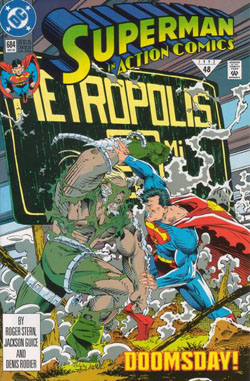 |
|
"Doomsday is Near" featured Action Comics # 684 by Stern, Jackson Guice and Denis Rodier. This story was a significant installment that led to the eventual death of Superman.
|
But since I don’t have any real memories of the place, it’s hard to get too upset. What does make me sad is the loss of the Diana Theater, which once stood next door to the hospital. It was also ripped down for that parking lot. I watched a lot of great Saturday matinees in that theater.
The Diana Theater is where I first saw the Three Stooges, before they were on television! I was about five at the time, and my grandmother had taken me to the Diana. I couldn’t tell you what the main feature was, but in those days the Diana always screened a cartoon and a short subject beforehand. I remember being surprised when this black-and-white image came up on the screen – everything else was in color – and I asked Grandma what this was. And she told me that the feature would follow this short film, and that I shouldn’t worry because, “These are the Three Stooges. They’re very funny!” And, of course, they were. I believe we watched "Vagabond Loafers", the remake with Shemp of "A Plumbing We Will Go."
So don’t ever let anyone tell you that women don’t like the Stooges. Of course, I had an exceptionally cool grandmother.
GK: What type of environment did you grow up in?
RS: Oxygen based, as I recall.
Okay, I’ll try to be serious. I suppose you could say we were a working class family. Dad was a machinist for a small tool-and-die company and eventually worked his way up to foreman. At any rate, he got his hands dirty and worked hard for the money. My folks were both Depression Era babies, so I grew up learning the values of hard work and frugality. Even so, I never really wanted for much, but maybe I just have simple tastes. There was always plenty of food on the table. We may not have been rich, but we sure had a lot of fun. That may sound like a cliché, but it’s the truth. I remember a lot of picnics and road trips, cookouts and drive-in movies.
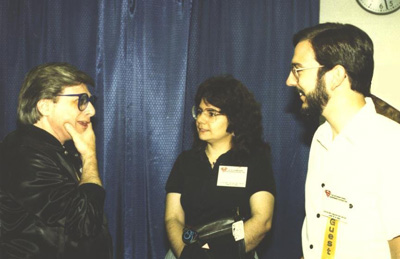 |
|
Roger and his lovely wife Carmela meet Harlan Ellison at the Superman Expo in Cleveland, 1988.
|
And there were always lots of newspapers, magazines, and books around when I was growing up. Everyone in the family read. Even before I could read, I already had my own stack of Little Golden Books. My parents and grandparents were always reading to me.
And since I was a child of the ’50s, there was also television, of course. I remember we had this cabinet model TV – a Philco, I think – that also had a built-in radio and record player. This is probably way more than anyone needs or wants to know. But the TV was important in that it first introduced me to Superman. Also to the Lone Ranger, Rocky Jones, Space Ranger, Roy, Gene, and Hoppy. Jackie Gleason, Lucy....all the old Warner Brothers cartoons. Made me what I am today.
I also listened to a lot of radio. It was close to the end of the age of radio comedy and drama, but many programs were simulcast on radio and television in those days, especially daytime and afternoon shows.
GK: In the past you've mentioned how you'd sit on your grandfather's lap, as he would read you the comics - are these some of your favorite comic book memories?
RS: Well, Grandpa read me the Sunday comics from the newspapers. So did my parents from time to time. So those weren’t comic book memories per se, but they are great family memories. And that was probably my earliest connection to comics. I loved those strips. Hearing them read aloud made me want to be able to read them for myself.
GK: Did your parents encourage your comic book reading?
RS: Mom and Dad encouraged me to read – period. Comic books were fine by them, as long as that wasn’t all that I read. They’d read comic books when they were kids, after all, so they never bought into all the Wertham malarkey. And anyway, the ECs and the crime comics were pretty much gone by the time I started reading. More’s the pity.
GK: So which were the comics that enraptured while you growing up? Marvel? DC?
RS: Well, I was 11 when Fantastic Four #1 went on sale, but comic book distribution was terrible in Indiana back then, so I didn’t see any Marvel Comics until I was 13 or 14. For me, it was mainly Dell and DC, with an occasional Archie or Harvey Comic thrown into the mix. Oh, and by some odd happenstance, I found a copy of Space Adventures #33 with Steve Ditko’s first Captain Atom story. That was one of the three comics that I read over and over until the covers fell off.
Early on, I read a lot of great Carl Barks Donald Duck and Uncle Scrooge stories, without knowing, of course, who Carl Barks was. And since I knew Superman from television, when I discovered his comics, I also discovered Batman and Green Arrow and Aquaman and the Martian Manhunter. Oh, and let’s not forget Congorilla and Roy Raymond, TV Detective. And then, the Flash and Green Lantern and the Justice League came along, and I was seriously hooked. Give me any of Julie Schwartz’s books in those days, and I would read quietly in the corner for hours.
I didn’t really discover Marvel until I was in high school. But once I did, I was hooked all over again.
GK: What was your major in college? And what was your first job out of school?
RS: Radio and Television. Got my B.A. from Indiana University, though I believe they changed the name of the department – it’s now “Telecommunications” instead of Radio & TV. But it still doesn’t mean we can fix your set. I actually started out thinking I’d become an engineer, but while in engineering school, I started working at the campus radio station and decided I liked that a lot more. I transferred to IU, and worked at the student-run station, WIUS. I probably learned as much there as I did from my R-&-TV classes.
And about three weeks after leaving school, I landed a staff job at WXLW in Indianapolis. That was – what? – January, 1973. “It all began at a little 5000-watt day-timer...”
GK: You were a copywriter at that radio station for a while. Were there any memorable ads (or slogans) you wrote?
RS: Well, there were a lot of commercials for Indianapolis Raceway Park, “Where the Great Ones Run!” They were a major account for the station. We also did a lot of crazy promotions, like “Super XL has Balls!” But I can’t take credit for that one. And I should point out that the only way a radio station could possibly have gotten away with that – in Indiana, in the early 1970s – was that we were giving away an Indianapolis Pacers basketball every hour. “So be listening for your chance to call in and win!”
You have to remember, this was years before the advent of Howard Stern. No relation, by the way, but I’m told he did read my first book.
GK: You were eventually fired from that radio station; was this one of the things that led you more into thinking about starting a career in comics? What led to the firing?
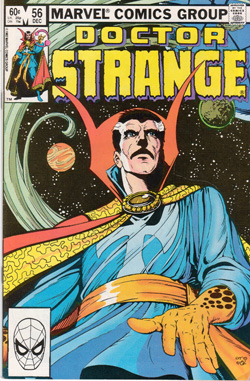
|
|
"A Mystic Reborn!" featured in Doctor Strange #56 by Stern, Paul Smith, and Terry Austin. The arrival of Paul Smith triggered an exciting new direction for the character that always stayed true to the classic tales of Lee and Ditko.
|
RS: Ah, yes, one of several jobs I’ve been fired from over the years. I worked at WXLW for a little over two-and-a-half years. During that time we went through two or three disc jockeys, a couple of newsfolk, God knows how many salespeople. The place was a regular revolving door for salespeople. We also changed owners and format. Eventually, we acquired a new station manager who had an unemployed friend. Suddenly, I was unemployed, and said friend had my job. Can’t be too angry about that, though. Getting fired ultimately led to much better things. But I did get some satisfaction in learning – long after the fact – that my replacement didn’t last long and neither did the guy who fired me.
But I never seriously considered pursuing a career in comics back then. I thought that – at most – I might get a chance to dabble in the field. Most likely through fanzines. Little did I know.
GK: What lured you into fandom? And how did you get into CPL (Contemporary Pictorial Literature)?
RS: We need to back up a little for that. After a high-school buddy of mine introduced me to Marvel Comics, fandom sort of came along as a package deal. Marvel ran small classifieds in those days, and a few early fanzine publishers were running ads there, which is how I discovered the old Rocket’s Blast Comic Collector, and the ads in the RBCC led to my getting a dozen or so late-sixties fanzines. And through one of those ’zines, I first made contact with Duffy Vohland, Roger Slifer, Dave Hartman, Larry Brnicky, and a few other guys roughly my age who lived in Indiana and collected comics. I was in college by the time we all met face-to-face. I remember one summer weekend they more or less shanghaied me off to Kentucky. That’s when I first met Don Rosa, who probably had more comics than the rest of us combined. Don and I have been friends ever since.
I don’t remember exactly when I first met Bob Layton, but I think it was probably sometime in 1973. At the time, Bob was in food services and moonlighting as a comics dealer out of his apartment. That apartment became a sort of nexus for our fan activities. Some of us lived to the north of Indianapolis, others to the south. But Bob was the only one of us who actually lived in the city. Once we’d all crossed paths, CPL really started to become a fanzine. Before that it had been Bob’s sales catalog. But he was interested in drawing more and writing some, and within a few issues, CPL turned into an honest-to-gosh ’zine. I wound up writing my first comics story for Bob.
GK: How impressionable was it meeting Bob Layton in the early days of CPL? Were you and he like-minded about comics?
RS: How “impressionable” was it? Well, I don’t remember a lot of the fine details of our first meeting; it was thirty years ago after all. But we hit it off pretty well. Bob was about three years younger than me. We liked a lot of the same comics, artists, and writers.
GK: What sort of atmosphere was there at CPL? And who were some of the memorable folks that contributed to it?
RS: Oh, my...how to describe it! Frenetic? Zany? We were really just a bunch of kids having fun. You ever see any of those old Judy Garland and Mickey Rooney musicals of the ’40s? You know, “Hey, we’ve got some costumes!”....“Well, my uncle has a barn!”....“Let’s put on a show!” It was a lot like that. Occasionally, we’d even break into song. Really. Anything from "Happy Trails To You" to "Call Any Vegetable."
I think that Duffy Vohland was living in Ohio and working with Dan Adkins by the time CPL came together, so he was probably contributing from a distance. Eventually, both he and Slifer wound up on staff at Marvel. After Slifer moved east, the staff consisted mainly of Bob, his then-wife Lee, Phil Wesner, and yours truly. We kept in touch with the other writers and artists mainly by the mail, though there’d be occasional weekenders and convention get-togethers.
GK: You met John Byrne through CPL; what was it about his early fan art that attracted CPL to feature his artwork so many times? And how did your friendship start?
RS: Well, there was always a lot of personality to John’s work. And there was thought behind his art, even before he fully integrated anatomy and storytelling. John’s early work seemed influenced by both Neal Adams and Jack Kirby, with maybe a little Bernie Wrightson and Gil Kane thrown in. Not a bad foundation to build on. Plus, he was fast and worked cheap.
I’m not sure, but I think Bob and I split up a list of contributors that we wanted to keep in touch with, and John wound up on my half of the list. At any rate, as soon as we were all working on CPL, John and I became fairly regular correspondents, pen pals of a sort. Turned out that, despite the fact that we’d been born in different hemispheres, our tastes overlapped quite a bit. Whenever we got together at conventions, we’d start doing old routines from The Goon Show.
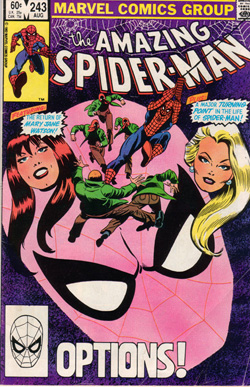
|
|
"Options!" featured in Amazing Spider-Man #243 by Stern, John Romita Jr. and Dave Simons. Stern’s Peter Parker, with all of his personal baggage, only added more fuel to all the chaos in Spider-Man’s life.
|
GK: Was CPL a successful venture when you started working more on it?
RS: Well, I know that CPL brought in enough money that we could pay the printer and produce more issues – with maybe enough left over to pay Bob’s telephone bill – but none of us were ever going to get rich from it. We all worked on CPL for the same reason we read comics – for the sheer fun of it. I’d say we succeeded in that. It also raised our visibility enough that most of us eventually landed professional comics gigs. But we didn’t know that was going to happen. At least, I didn’t.
GK: Was it an important learning experience for you as a writer?
RS: I think so. Part of my day job at the time was writing commercial copy. CPL gave me a place to stretch different muscles and an outlet where I could produce articles, reviews, and eventually comics. All very much seat-of-the-pants learning, mind you, but that’s probably what I needed at the time.
GK: In a way Charlton Bullseye spun off from CPL. What are your best memories of it? Working with Ditko and Toth art, perhaps?
RS: I never really worked directly with Toth. I came up with a rough plot idea and one line of dialogue for the Question story Toth drew, but Mike Uslan turned it into a finished script.
The Ditko Captain Atom story was another matter. That’s the one I scripted. And all I had to go by were the penciled pages. No one at Charlton knew what had happened to Dave Kaler’s plot. Luckily, it was Ditko art, and the storytelling was superb. You could tell exactly what was going on from just the pencils. Even so, I was scared silly the whole time I was scripting that story. That’s why I used the Jon G. Michels pen name for the first half. By the second half, I had enough confidence to use my own name. I reread the story recently, and it’s not too excruciatingly bad, but I would love a chance to rework it, knowing what I know now.
I’m just glad I eventually got a chance – years later – to write stories that Ditko drew at Marvel. By that time, I knew what I was doing.
GK: Were you starting to get a feel for the industry with during this time? Were you learning the craft from within?
RS: A feel for the industry? Maybe a watered-down one. Bob and I were still out in the middle of Indiana at the time. The comics industry was hundreds of miles away. At best, we were learning from off to one side.
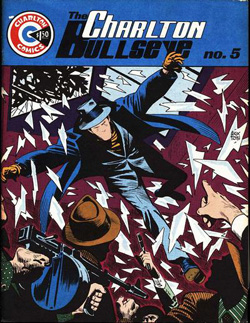
|
|
Charlton Bullseye #5 featured a collaboration between Michael Uslan and Alex Toth based on a Question plot from Rog.
|
GK: What was the best learning experience about comics you picked up?
RS: Well, we weren’t really “in comics” just yet. It was helpful seeing the work appear in print. There’s nothing like getting a printed copy of something to see what worked and what didn’t.
GK: How taxing was it starting as a writer back then? And what was your first sale?
RS: I think my first sale was an article for FOOM, Marvel’s old in-house fanzine. My first sale of a comics story was a full-script for Charlton’s Phantom comic. Don’t go looking for it, though. The title was cancelled long before the story was ever drawn.
Oddly enough, I just recently wrote a Phantom story that – once again – most American readers will never see. It’s for Egmont, one of Europe’s largest publishers.
GK: Were you trying to break in at Charlton as a writer of a monthly?
RS: Oh, hell, no. I still had a day job at the time. I could never have made a living on Charlton rates. They paid their writers only five dollars a page.
GK: What made you decide that you wanted to go to Marvel and move to New York? Was it a decision you had to think over a lot?
RS: Not really. After I lost my job at the radio station, I spent about four months collecting unemployment and sending out résumés. The broadcasting market was very tight at the time, and I was getting no responses. I had begun to suspect that my radio career was over, and I was starting to go a little stir crazy. That’s when I got a call from Roger Slifer, offering me a chance to test for a Marvel staff job. I figured, hey, I might as well give it a shot.
GK: What did this "editorial test" consist of? Who interviewed you? When was this? Who was the editor-in-chief at the time?
RS: That was in December of 1975. Marv Wolfman was the man at the time, though the job wasn’t really called “Editor-in-Chief” in those days. Aside from Roy Thomas and Len Wein, who were writer/editors, there was the “Color Editor” and the “Black-&-White Editor” – Marvel was still publishing black & white magazines in those days. Anyway, Marv was the editor in charge of all the four-color comics that Marvel published. Well...all of the ones that weren’t under the control of writer/editors. And he didn’t really interview me beforehand.
Basically, I came in and took a proofreading test, which consisted of going over photocopies of a Power Man story – one that had been fairly poorly lettered and inked – with a blue pencil and trying to catch as many mistakes as I could. Oh, and just to make things interesting, there was no copy of the script to compare it to. “Here you go, chump, good luck!” I think you’d pass if you could catch at least as many mistakes as the guys already on staff could. And I must have passed, because afterwards I was invited to lunch with Marv and he basically said, “The job consists of proofreading letters pages and stories for the reprint books. You interested?” “Uh, sure.” “Okay, you start officially after the first of the year. We’ll pay you freelance until then.” I was too punchy to think of asking how much it paid.
Anyway, just like that, I went from being unemployed to being an assistant editor at the number one comics company in America. I wound up working for Marvel for the next eleven years.
And then, I was fired. Man, I just can’t keep a job.
GK: Who were you an assistant editor for? And how did you move up to full-fledged editor? Which books did you edit and how long were you an editor?
RS: All of us assistants answered to the editor, who was Marv. And then, briefly, Gerry Conway. And then, Archie Goodwin.
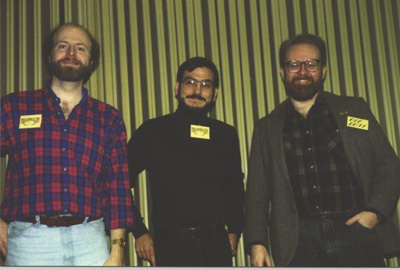 |
|
The X-Men Boys, back together again... Terry Austin, Roger Stern, and John Byrne cutting up at a MidOhioCon. Roger was the editor of Uncanny X-Men from issues 113 to 131 during the now legendary Claremont/Byrne/Austin run of the title.
|
And after Archie stepped down, the whole editorial structure was reorganized, with an official Editor-in-Chief, editors, and assistants. Marvel had grown so much since the '60s that it was just no longer feasible for one individual to be editor of the whole shooting match. There were thirty-five to forty titles being produced every month. When Jim Shooter was offered the job, he told management that the previous model just didn’t work anymore. To the surprise of just about everybody, they agreed to change it.
So, when Jim became Editor-in-Chief, he asked me to be one of his editors. At first it was just Bob Hall and me in the color line. I was a line editor for about two years. Jim Salicrup was my assistant, and we were in charge of most of the Avengers related titles: Avengers, Captain America, Iron Man, and Ms. Marvel, plus Master of Kung-Fu, John Carter: Warlord of Mars, Marvel Two-In-One, Spider-Woman – and those were the monthlies. We also edited Captain Marvel, Marvel Premiere, Marvel Spotlight and (briefly) Power Man & Iron Fist – those were bi-monthlies. We were responsible for overseeing the production of eleven books a month. Wait, that’s ten...what am I forgetting?
Oh, yeah. We also had a little book called X-Men. Whatever happened to that title, anyway?
GK: How strange (or difficult) was it for you to be the editor for two CPL alumni when John Byrne was on X-Men and Bob Layton was on Iron Man?
RS: Wasn’t strange at all. It was more like old home week. I was assured of a couple of good-looking books, which in turn made me look good. And it gave me an excuse to gab about comics with John. Long distance. And Marvel picked up the tab!
GK: Can you describe what it was like working on X-Men with Chris Claremont, John Byrne, and Terry Austin?
RS: Fun. Big fun. Wondrous fun. Chris, by that point, was already a very good wordsmith, and he brought a lot of passion to his work. Ditto for John on the pencils. They could butt heads as to story direction, but there was a great synergy between the two of them. And besides, I got to referee, so I always had the last word.
And Terry, of course, was John’s first really great inker. His line complemented John’s perfectly.
Of course, Terry’s a great cartoonist in his own right. We later did a series of wacky one-page gags for Marvel Super-Heroes and What If. And that’s not to mention all the great inking he did on Doctor Strange.
But we were talking about The X-Men, weren’t we? Let’s not forget Tom Orzechowski and Glynis Oliver (then Wein). Orz’ lettering and Glynis’s coloring were the perfect finishing touch to the book. Everyone was top-notch on that title.
GK: What do you think made the team and their work so memorable?
RS: They were a bunch of young guys getting a chance to prove themselves with a book that had at best been a minor seller. And they produced a consistently good comic that got better every issue. The X-Men during that period was exciting. It was entertaining. It would spin a story that caught the readers by surprise. It made them go, “Wow!” and brought them back the next month for more. It was ‘the’ comic of the hour.
And I helped.
GK: What do you remember about working on Marvel Premiere #50? Did you have to deal with Alice Cooper?
RS: There was no “have to”… I got to deal with Alice, and that was great fun. But none of that would have happened if not for Jim Salicrup. He sold Marvel on the idea and made the contacts with Alice’s people. He lined up the artists and put the whole thing together. I got involved only because…well, Jim had the idea of basing the story on the themes and characters that Alice had developed on his (then) latest album, From the Inside. He had lined up Ed Hannigan to write the story, but for some reason Ed couldn’t plot the issue, and the first deadline was approaching. So I volunteered write the plot. Jim gave me the album and some of his ideas for the story. And I went home, listened to the album, and roughed out the plot.
And then, we flew to Detroit to join Alice on tour.
I still don’t know how Jim pulled that one off. We put the plane tickets on my Visa card, but Marvel wound up reimbursing me – I think. Anyway, Alice was on tour, and Jim and I flew to Detroit, stayed in the same hotel as the band, and got free seats – good ones – for the concert. The next day, we met with Alice and went over the plot with him. He made some suggestions – again, good ones – which we incorporated into the plot. Then we thanked him for his hospitality and flew back to New York.
I typed up the revised plot. Tom Sutton drew it. Ed scripted it. Orz lettered it. Terry inked it. Marie Severin colored it. And a bunch of people bought it.
It was a fun project to be part of. But, like I said, Salicrup should get the credit for making it happen.
Alice is a nice guy, by the way. I hear he’s a helluva golfer, too.
GK: Please tell me what the Bullpen was like back then?
RS: Remember how when you were in college, when you’d be up all night finishing an important paper? And it would get to be 4:30, five o’clock in the morning, and you’d finally wrap it up, but you were so wired that you thought your head was about to explode? And then, someone would say something that struck you as so funny that you’d dissolve into gales of hysterical laughter? And all without the use of drugs?
Working in the Bullpen was a lot like that. I always tried to get there early in the morning – 7:30, eight o’clock at the latest – so I could get a jump on things before the phones started ringing. After a few weeks, John Verpoorten, bless him, gave me a key to the back door, so I wouldn’t have to wait for him to open up in the morning. And a lot of us often worked well past five, especially if things were piling up. Then we’d go out for dinner, maybe catch a movie, and go home. Then we’d get up the next day and do it again.
And in my spare time I was writing Doctor Strange and The Incredible Hulk.
I sometimes look back and wonder, “How the hell did I manage to live like that for so long?” Of course, we were all younger then, and we knew no fear.
We’d all get a little punchy at times, usually with hilarious results. I remember once, at the end of a very long day, I was still at my desk and Archie Goodwin had plopped down in a chair nearby to shoot the breeze before he left for home. Allen Milgrom was standing in the doorway and all of a sudden, he flipped a switch on the wall and said, “You can’t escape now, Arch! I’ve electrified the floor.” Archie immediately jumped up on his chair and yelled, “Hah! That’s what you think!” And then, as both Al and I cracked up, Archie proceeded to circumnavigate the room, leaping from desktop to desktop and making his way across filing cabinets as though he were a rock-climber…or possibly Spider-Man. But the next-to-last thing he stepped on was a sort of wicker-bottomed chair that Jim Shooter had been using in lieu of a desk chair. Archie’s foot went right through the wicker, but somehow – somehow! – he managed to hop up onto another desk, pull his foot free, and bound across the threshold of the door. All without ever once stepping on the floor and being “electrocuted.”
Of course, the next morning, when Jim came into work, the first thing he said was, “What happened to my chair?” And I cracked up all over again.
GK: What was working for Shooter like?
RS: Oh, I got along with Jim just fine. Sure, sometimes we’d argue and butt heads and occasionally piss each other off, but that happens. We both started working for Marvel within a few weeks of each other, so we were the new kids.
I remember one time we were sitting around the editorial Bullpen – well after five o’clock. It was just Jim, Milgrom, and me. One of us made a remark about seeing eye-to-eye on something, and Jim wised off about how no one ever saw eye-to-eye with him because of his height. (He’s six feet, seven inches tall. Though he’d sometimes claim to be 5’19”.)
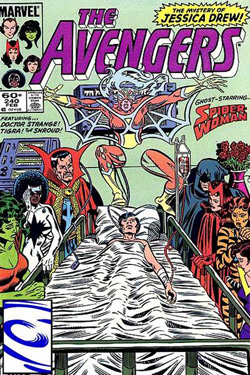
|
|
"The Ghost of Jessica Drew” featured in Avengers #240 by Stern, Al Milgrom, and Joe Sinnott. Did you really think that Brian Michael Bendis was the only guy who could write a good Jessica Drew story?
|
Anyway, I jumped up on my desk and yelled, “Oh, yeah?” At which point, Milgrom – being an even bigger wiseguy than I am – says, “Yeah, let’s show this guy, Sterno!” and runs around in front of my desk. So I climbed onto his shoulders. And Al walked across the room with me sitting on his shoulders, going, “Okay, smile when you say that, Shorty!” Jim just turned into Jello. We were all breaking up. But about then, Al started to realize that I weighed more than he thought I would. And I started to wonder, “How am I getting down without breaking my neck?” And Jim was no help because he’s laughing so hard that he’s on the verge of falling out of his chair and sliding onto the floor. And you know, I don’t remember how I got down. I think Al tried backing us up to a wall or something. Somehow we survived.
That’s just one of many ‘breaking up Jim Shooter’ stories. I have dozens of them. Come to think of it, a lot of these stories also involve Milgrom. Maybe we should go on the road.
You know, I always thought that part of Jim’s problem was that he’s so damn tall. At 6’7”, he would intimidate people without meaning to. And, of course, there was the fact that he blew in from out of town and disrupted the editorial pecking order. I know that there were people whose noses were out of joint, who figured that they should have had his job.
The job! That was biggest part of the problem. Anyone who’s editor-in-chief of Marvel Comics might as well paint a target on their chests. You sit behind that desk, and you automatically become the designated bad guy. The only man I know of who went through that position and was still loved and respected was Archie Goodwin. Only a no-good rat-bastard would hate that man. The human race doesn’t produce anywhere near enough Archie Goodwins.
GK: The whole time you were an editor; did you know you wanted to be more on the freelancing writing side than doing the steady editorial work? Was it a big gamble back then for you?
RS: I thought it was. There was a certain degree of security in being an editor, even though the hours were long and it never paid all that well – especially for anyone living in the city. But after a few years of being an editor all day and writing at night and weekends, I was running myself ragged. And I was always worried about meeting my deadlines. Which made things even worse – how could I bug my freelancers about getting work in on time, if I was struggling to do the same? My initial solution was to give up my writing assignments. But once I did that I was miserable.
I really missed writing, and all the frustrations of being an editor were starting to get to me. So, I was sitting at home one night, being miserable, and Jim gave me a call. I remember, he said something like: “You’re not happy in your job, are you?” “No, not really.” “You enjoy writing, why don’t you do that full time?” “Because I couldn’t make a living doing it.” And he said, “Sure, you could.” Then he started talking terms and rates, and in just a few weeks, I had an exclusive contract to write for Marvel Comics full time.
Continue to: PAGE 2 • PAGE 3
Website design by Doug Roberts and John Thomas. All comic images on this page are copyright of Marvel Comics, DC Comics or respective rights holders. All photos on this page are owned and used with permission by Roger Stern. This site is for reference purposes and promotion of the Masterworks line of books as well as Marvel Comics and their properties.


